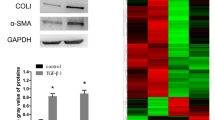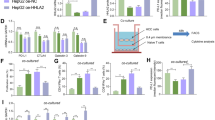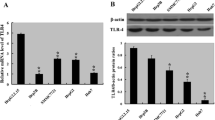Abstract
The molecular mechanisms of innate immunity are closely associated with the development of non-alcoholic fatty liver disease (NAFLD). TNF-α is a key cytokine involved in the pathogenesis of metabolic inflammation like NAFLD. Melanoma differentiation-associated gene 5 (MDA5) is a member of the intracellular RNA helicase family proteins that play a pivotal role in an antiviral immune response. Previous studies have demonstrated that TNF-α induces the expression of MDA5 in some types of cells. However, the correlation between TNF-α and the expression of MDA5 in hepatocytes remains unknown. In the present study, we used two human hepatocellular carcinoma cell lines, HuH-7 and HLE, and examined the expression of MDA5 in these cells upon stimulation with TNF-α. The expression of MDA5 induced by TNF-α was analyzed by quantitative real-time RT-PCR and western blotting. Next, RNA interference against MDA5 was performed and the expressions of CXCL10 and STAT1 were examined. We found that the expression of MDA5 had increased upon stimulation with TNF-α in a concentration-dependent manner. Gene silencing against MDA5 suppressed the expression of TNF-α-induced CXCL10 in both cells. In HLE cells, gene silencing of MDA5 impaired STAT1 phosphorylation 24 h after stimulation with TNF-α. On the other hand, TNF-α-induced STAT1 phosphorylation was not detected in HuH-7 cells. These results indicated that MDA5 positively modulated the TNF-α-induced expression of CXCL10 in both STAT1-dependent and -independent manner and may be associated with metabolic inflammation in the liver.






Similar content being viewed by others
References
Tilg, H., and A.R. Moschen. 2010. Evolution of inflammation in nonalcoholic fatty liver disease: the multiple parallel hits hypothesis. Hepatology 52 (5): 1836–1846.
Hotamisligil, G.S., N.S. Shargill, and B.M. Spiegelman. 1993. Adipose expression of tumor necrosis factor-alpha: direct role in obesity-linked insulin resistance. Science 259 (5091): 87–91.
Tomita, K., G. Tamiya, S. Ando, K. Ohsumi, T. Chiyo, A. Mizutani, N. Kitamura, K. Toda, T. Kaneko, Y. Horie, J.Y. Han, S. Kato, M. Shimoda, Y. Oike, M. Tomizawa, S. Makino, T. Ohkura, H. Saito, N. Kumagai, H. Nagata, H. Ishii, and T. Hibi. 2006. Tumour necrosis factor alpha signaling through activation of Kupffer cells plays an essential role in liver fibrosis of non-alcoholic steatohepatitis in mice. Gut 55 (3): 415–424.
Rivera, C.A., P. Adegboyega, N. van Rooijen, A. Tagalicud, M. Allman, and M. Wallace. 2007. Toll-like receptor-4 signaling and Kupffer cells play pivotal roles in the pathogenesis of non-alcoholic steatohepatitis. Journal of Hepatology 47 (4): 571–579.
Marra, F., and F. Tacke. 2014. Roles for chemokines in liver disease. Gastroenterology 147 (3): 577–594.
Chen, W., J. Zhang, H.N. Fan, and J.S. Zhu. 2018. Function and therapeutic advances of chemokine and its receptor in nonalcoholic fatty liver disease. Therapeutic Advances in Gastroenterology 11: 1–13.
Zhang, X., J. Shen, K. Man, E.S.H. Chu, T.O. Yau, J.C.Y. Sung, M.Y.Y. Go, J. Deng, L. Lu, V.W.S. Wong, J.J.Y. Sung, G. Farrell, and J. Yu. 2014. CXCL10 plays a key role as an inflammatory mediator and a non-invasive biomarker of non-alcoholic steatohepatitis. Journal of Hepatology 61 (6): 1365–1375.
Narumi, S., H. Yoneyama, H. Inadera, K. Nishioji, Y. Itoh, T. Okanoue, and K. Matsushima. 2000. TNF-alpha is a potent inducer for IFN-inducible protein-10 in hepatocytes and unaffected by GM-SCF in vivo, in contrast to IL-1beta and IFN-gamma. Cytokine 12 (7): 1007–1016.
Kang, D.C., R.V. Gopalkrishnan, Q. Wu, E. Jankowsky, A.M. Pyle, and P.B. Fisher. 2002. Mda-5: an interferon-inducible putative RNA helicase with double-stranded RNA-dependent ATPase activity and melanoma growth-suppressive properties. Proceedings of the National Academy of Sciences of the United States of America 99 (2): 637–642.
Yoneyama, M., M. Kikuchi, K. Matsumoto, T. Imaizumi, M. Miyagishi, K. Taira, E. Foy, Y.M. Loo, M. Gale Jr., S. Akira, S. Yonehara, A. Kato, and T. Fujita. 2005. Shared and unique functions of the DExD/H-box helicases RIG-I, MDA5 and LGP2 in antiviral innate immunity. Journal of Immunology 175 (5): 2851–2858.
Guo, H., D. Jiang, D. Ma, J. Chang, A.M. Dougherty, A. Cuconati, T.M. Block, and J.T. Guo. 2009. Activation of pattern recognition receptor-mediated innate immunity inhibits the replication of hepatitis B virus in human hepatocyte-derived cells. Journal of Virology 83 (2): 847–858.
Dansako, H., M. Ikeda, and N. Kato. 2007. Limited suppression of the interferon-beta production by hepatitis C virus serine protease in cultured human hepatocytes. The FEBS Journal 274 (16): 4161–4176.
Cao, X., Q. Ding, J. Lu, W. Tao, B. Huang, Y. Zhao, J. Niu, Y.J. Liu, and J. Zhong. 2015. MDA5 plays a critical role in interferon response during hepatitis C virus infection. Journal of Hepatology 62 (4): 771–778.
Zhang, Z., C. Filzmayer, Y. Ni, H. Sültmann, P. Mutz, M.S. Hiet, F.W.R. Vondran, R. Bartenschlager, and S. Urban. 2018. Hepatitis D virus replication is sensed by MDA5 and induces IFN-β/λ responses in hepatocytes. Journal of Hepatology 69 (1): 25–35.
Tatsuta, T., T. Imaizumi, T. Shimoyama, M. Sawaya, K. Tanji, T. Matsumiya, H. Yoshida, K. Satoh, and S. Fukuda. 2012. Expression of melanoma differentiation associated gene 5 (MDA5) is increased in human gastric mucosa infected with Helicobacter pylori. Journal of Clinical Pathology 65 (9): 839–843.
Funabiki, M., H. Kato, Y. Miyachi, H. Toki, H. Motegi, M. Inoue, O. Minowa, A. Yoshida, K. Deguchi, H. Sato, S. Ito, T. Shiroishi, K. Takeyasu, T. Noda, and T. Fujita. 2014. Autoimmune disorders associated with gain of function of the intracellular sensor MDA5. Immunity 40 (2): 199–212.
Dias Junior, A.G., N.G. Sampaio, and J. Rehwinkel. 2019. A balancing act: MDA5 in antiviral immunity and autoinflammation. Trends in Microbiology 27 (1): 75–85.
Xu, M., P.P. Liu, and H. Li. 2019. Innate immune signaling and its role in metabolic and cardiovascular diseases. Physiological Reviews 99 (1): 893–948.
Pan, Y., G.M. Li, H.G. Zhong, M.J. Chen, T.T. Chen, L.L. Gao, H.W. Wu, and J. Guo. 2016. RIG-I inhibits pancreatic β cell proliferation through competitive binding of activated Src. Scientific Reports 6: 28914.
Imaizumi, T., N. Yagihashi, K. Kubota, H. Yoshida, H. Sakaki, S. Yagihashi, H. Kimura, and K. Satoh. 2007. Expression of retinoic acid-inducible gene-I (RIG-I) in macrophages: possible involvement of RIG-I in atherosclerosis. Journal of Atherosclerosis and Thrombosis 14 (2): 51–55.
Toyoda, H., T. Kumada, S. Kiriyama, M. Tanikawa, Y. Hisanaga, A. Kanamori, T. Tada, S. Kitabatake, and Y. Murakami. 2013. Association between hepatic steatosis and hepatic expression of genes involved in innate immunity in patients with chronic hepatitis C. Cytokine 63 (2): 145–150.
Imaizumi, T., T. Arikawa, T. Sato, R. Uesato, T. Matsumiya, H. Yoshida, M. Ueno, S. Yamasaki, T. Nakajima, M. Hirashima, K. Sakata, Y. Ishibashi, S. Toh, C. Ohyama, and K. Satoh. 2008. Involvement of retinoic acid-inducible gene-I in inflammation of rheumatoid fibroblast-like synoviocytes. Clinical and Experimental Immunology 153 (2): 240–244.
Miyamoto, M., T. Fujita, Y. Kimura, M. Maruyama, H. Harada, Y. Sudo, T. Miyata, and T. Taniguchi. 1988. Regulated expression of a gene encoding a nuclear factor, IRF-1, that specifically binds to IFN-β gene regulatory elements. Cell 54 (6): 903–913.
Geller, D.A., D. Nguyen, R.A. Shapiro, A. Nussler, M. Di Silvio, P. Freeswick, S.C. Wang, D.J. Tweardy, R.L. Simmons, and T.R. Billiar. 1993. Cytokine induction of interferon regulatory factor-1 in hepatocytes. Surgery 114 (2): 235–242.
Imaizumi, T., T. Aizawa-Yashiro, T. Matsumiya, H. Yoshida, S. Watanabe, K. Tsuruga, T. Tatsuta, F. Xing, R. Hayakari, P. Meng, and H. Tanaka. 2013. Interaction between interferon-stimulated gene 56 and melanoma differentiation-associated gene 5 in toll-like receptor 3 signaling in normal human mesangial cells. American Journal of Nephrology 37 (2): 118–125.
Imaizumi, T., K. Murakami, K. Ohta, H. Seki, T. Matsumiya, P. Meng, R. Hayakari, F. Xing, T. Aizawa-Yashiro, T. Tatsuta, H. Yoshida, and H. Kijima. 2013. MDA5 and ISG56 mediate CXCL10 expression induced by toll-like receptor 4 activation in U373MG human astrocytoma cells. Neuroscience Research 76 (4): 195–206.
Tomita, K., A. Kabashima, B.L. Freeman, S.F. Bronk, P. Hirsova, and S.H. Ibrahim. 2017. Mixed lineage kinase 3 mediates the induction of CXCL10 by a STAT-1-dependent mechanism during hepatocyte lipotoxicity. Journal of Cellular Biochemistry 118 (10): 3249–3259.
Tomita, K., B.L. Freeman, S.F. Bronk, N.K. LeBrasseur, T.A. White, P. Hirsova, and S.H. Ibrahim. 2016. CXCL10-mediates macrophage, but not other innate immune cells-associated inflammation in murine nonalcoholic steatohepatitis. Scientific Reports 6: 28786.
Author information
Authors and Affiliations
Corresponding author
Ethics declarations
Conflict of Interest
The authors declare that they have no conflict of interest.
Additional information
Publisher’s Note
Springer Nature remains neutral with regard to jurisdictional claims in published maps and institutional affiliations.
Rights and permissions
About this article
Cite this article
Kawaguchi, S., Sakuraba, H., Haga, T. et al. Melanoma Differentiation-Associated Gene 5 Positively Modulates TNF-α-Induced CXCL10 Expression in Cultured HuH-7 and HLE Cells. Inflammation 42, 2095–2104 (2019). https://doi.org/10.1007/s10753-019-01073-3
Published:
Issue Date:
DOI: https://doi.org/10.1007/s10753-019-01073-3




